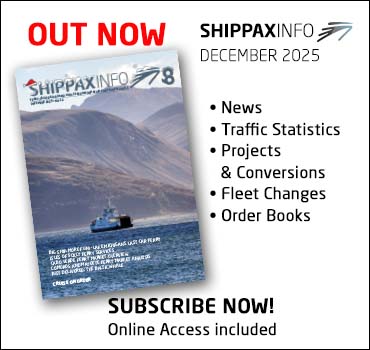
AURORA BOTNIA © Wasaline
Wasaline to evaluate battery enlargement and e-methanol conversion
FerryWith its dual-fuel LNG engines, the option to run on biogas, and batteries supported by extensive use of shore power, the 2021-built AURORA BOTNIA is already notable for its green profile. Now, Wasaline has again asked for Foreship’s help to push forward with the ship’s green transition – this time by evaluating a battery enlargement and e-methanol conversion.
Supporting Wasaline through the 2021 delivery at Rauma Marine Construction shipyard, Foreship mobilized over a decade of experience in the battery energy storage systems (BESS) use on ships for spinning reserve/blackout prevention, peak load shaving, load response, and zero-emission operations.
With IMO targets for ship emissions tightening and EU penalties and incentives to accelerate low-carbon fuel uptake from 2025, however, Wasaline asked Foreship to prepare a feasibility study on a possible extension or replacement of AURORA BOTNIA's existing BESS earlier this year.
The two-part project also foresees an evaluation of the technical impacts and business case for a partial engine conversion from LNG to e-methanol dual fuel.
“In a relatively short period, the potential of batteries to offer a bigger contribution to zero-emission ship power has advanced rapidly,” says Joonatan Haukilehto, Head of New Technologies, Foreship.
Foreship’s battery study evaluated 12 different BESS extension possibilities for return on investment and technical complexity. “We based our analysis on the improved energy efficiency of the vessel and the low price of shoreside electricity and factored in the shelter and cost incentives the energy type will offer under EU emissions arrangements,” said Haukilehto.
Based on complexity, cost, stored energy, power, and regulations, Foreship identified multiple scenarios to replace the existing 2.2 MWh BESS with a 6-8 MWh capacity system without major structural or electrical infrastructure work. In addition to evaluating the replacement of the existing BESS with many years of usable life ahead, Foreship evaluated keeping the NMC-type installation as-is and adding another battery storage space, thus increasing BESS capacity to 10-14 MWh.
“With cheap electricity available from shore power not only covering 100% of the ship’s power needs during port stays but also charging batteries, the retrofit could contribute up to 20% of overall ship energy needs,” says Haukilehto. “Furthermore, the vessel’s total energy efficiency is clearly improved by the possibility to run on a single engine on high load for the majority of voyages,” says Haukilehto.
The potential engine conversion to run on methanol would be quite straightforward, adds Haukilehto, given that many of the systems could use the same routing as existing LNG-related systems. While a separate methanol fuel treatment room would need to be factored in, fuel storage space would not be a major factor, given the short voyage involved and a favorable existing tank arrangement, he says.
Earlier this year, Wasaline, Liquid Wind and Umeå Energy signed a Letter of Intent for the supply of eMethanol: https://www.shippax.com/en/news/wasaline-liquid-wind-and-umea-energy-sign-letter-of-intent-for-the-supply-of-emethanol.aspx
© Shippax
dec 10 2024
Most read
MSC Cruises and Meyer Werft sign landmark agreement for up to six next-generation “New Frontier” class cruise ships
dec 15 2025
Incat Tasmania and Molslinjen sign contract for third battery-electric high-speed catamaran
dec 05 2025






















